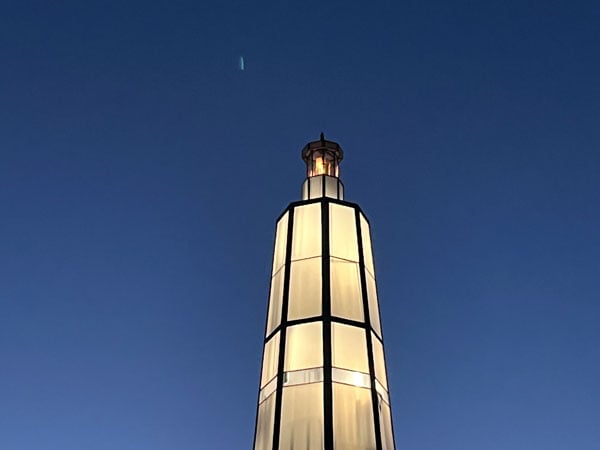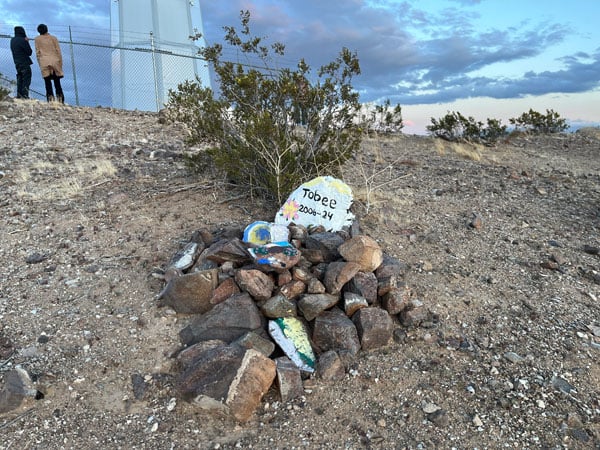To the Lighthouse

LA artist Daniel Hawkins built a lightouse in the Mojave. (Carolina A. MIranda)
In 2006, artist Daniel Hawkins was approaching the end of a cross-country drive when he hit the high desert in California. It was night and the sky was black and he recalls feeling unmoored. “You reach some of these areas in the desert, particularly without a full moon,” he says, “and you are in absolute void.”
That sensation ignited anxious feelings of agoraphobia. It also inspired an idea for a work of art: a marker that could serve as a beacon or anchor. Which is how his sculpture, Desert Lighthouse, a real-deal, 50-foot tall lighthouse, came to illuminate a small rise in the middle of the Mojave Desert — where there is nary an ocean in sight.
Desert Lighthouse resides off a dirt road in Hinkley, Calif., a rural community that lies about half a dozen miles from the nearest major highway and the crossroads town of Barstow. If Hinkley’s name rings a bell, that’s because it’s most famous as a site of environmental disaster: the town’s groundwater was contaminated with the heavy metal chromium-6 by Pacific Gas & Electric (PG&E), an incident that garnered headlines after a legal clerk named Erin Brockovich helped secure a massive settlement from the company. The story was later turned into a movie starring Julia Roberts.

Creosote covers the hillsides around Hinkley. (Carolina A. Miranda)
If Hinkley’s name evokes calamity, the presence of Hawkin’s lighthouse has added other narratives. It has become a site of pilgrimage but also reflection, and a curious point of pride in a town that is still contending with ongoing remediation efforts.
Last Saturday afternoon, I joined a caravan of four dozen people for a field trip to Desert Lighthouse led by Hawkins himself. Our first stop was Riley’s Place on old Highway 58, a well-worn bar offering karaoke and very frosty beer. Riley’s is one of the last businesses standing in Hinkley: the contamination, along with PG&E’s subsequent financial settlement, led the majority of residents to abandon the town. Now, just a few hundred people remain.

Riley's is the last surviving business in Hinkley. The beer, as advertised, is "damn good." (Carolina A. Miranda)
From there, we continued to the Hinkley Community Center, where we had dinner with John Turner, a personable activist who grew up in the area, and now runs the center. Turner told us that when the lighthouse started to go up on a hillside north of town in 2016, townspeople were unsure what to make of it. Some theorized that it was a military installation. (The town sits between Edwards Air Force Base and Fort Irwin.) Others thought it was built by PG&E. But as the lighthouse (along with Hawkins) became a familiar sight in town, it began to take on a more meaningful significance. Turner discussed some of the ongoing economic and environmental initiatives that might help Hinkley move beyond the disaster, and said, “...the lighthouse is a part of that — and we didn’t even know it at first.”
Hawkins completed Desert Lighthouse in 2017 (with the assistance of grants from the Center for Land Use Interpretation, the arts nonprofit West of Rome, and a crowdfunding campaign). Since then, the piece has taken on a life of its own. Townspeople have helped protect the site from would-be vandals. “I was at a water board meeting and this old man sidled up to me,” recalls Hawkins. “He tells me, ‘I saw some guys trying to take panels.’ He always carries an arm, and he said, ‘I told them to move along.’ So, he basically protected the lighthouse at gunpoint. That blew my mind!”
More poignantly, in 2018, some local residents began to spread the ashes of their loved ones at the site, building an improvised memorial with crosses and rocks. Hawkins has been moved by these gestures and hopes to install some sort of permanent structure that might serve as a place for the community to lay objects. “I’ve thought about some kind of plinth.”

A small memorial sits for Tobee sits within view of Desert Lighthouse. (Carolina A. Miranda)
Our tour landed at the lighthouse right at sunset. Dramatic cloud formations moved across a sky that was a gradient of orange, purple, and blue. Night crept in, the temperature dropped, and the lighthouse, which is illuminated from within like a lantern, cast a gentle light on the hillside around it. It is possible to visit Desert Lighthouse at any time, but going on a tour with Hawkins meant that we got to climb into the structure and get a bird’s eye view of creosote-covered hillsides bathed in otherworldly light.
The best experience, however, is to stand at a distance from the structure to bathe in its glow as the wind whips across the desert and the trains rattle in the distance. Lighthouses were built as a way of warning off sailors from dangers such as rocks. But as I watched the lantern rotate at the top of Desert Lighthouse, I didn’t feel peril. Simply, a gesture of warmhearted welcome.
🚨🚨🚨
Visiting Desert Lighthouse

On your own: The lighthouse resides on private land, but you can visit at any time, though sunset is best if you want to see it in operation. A dirt road leads to the site, so high clearance vehicles are best. Find more details and Google Map coordinates at desertlightouse.org.
On a planned tour: Hawkins plans to organize another tour to the site in the fall. A date has not been set, but you can sign up for the artist’s mailing list via the website or by following Hawkins’ Instagram account, @danielhawkinsart.
Not planning to be in the desert any time soon? Check out Hawkins’ book, Field Trip to the Desert Lighthouse, which features photography of the site, as well as essays by Doug Harvey and Tyler Stallings. Stallings’ remarkable essay is a reprint of a piece that appeared in Southwest Contemporary, and delves into the history of lighthouses, as well as the work’s significance.